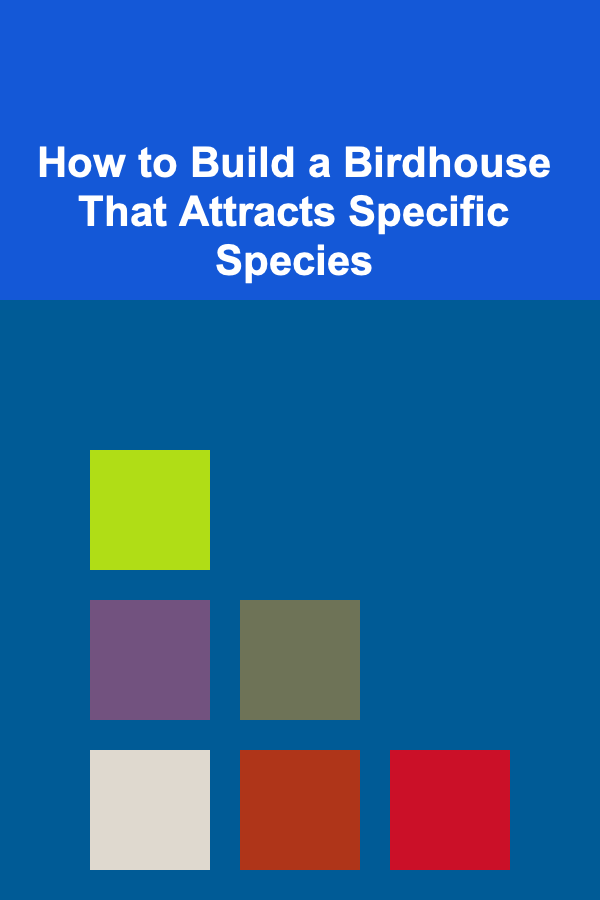
How to Build a Birdhouse That Attracts Specific Species
ebook include PDF & Audio bundle (Micro Guide)
$12.99$11.99
Limited Time Offer! Order within the next:

Birdhouses are more than just simple structures for birds to nest in---they are a way to enhance your garden, help local wildlife, and provide a safe space for specific bird species to thrive. Building a birdhouse that attracts a specific species involves understanding the unique needs and preferences of that species, from the size of the entrance hole to the location of the house and the materials used. Whether you are interested in attracting songbirds, owls, or woodpeckers, creating the right environment for each species is key to a successful birdhouse project.
This guide will walk you through the process of building a birdhouse that attracts specific bird species, including design tips, material suggestions, and advice on where to place the birdhouse. By the end, you'll have a better understanding of how to create a bird-friendly space that meets the needs of your feathered neighbors.
Choosing the Right Bird Species
Before you begin building your birdhouse, it is essential to determine which species you want to attract. Different bird species have unique preferences when it comes to nesting sites, and understanding these requirements will help you design the perfect birdhouse. Here are a few examples of common birds that you can attract and their specific needs:
Bluebirds
Bluebirds are a popular choice for birdhouse enthusiasts. They prefer open fields and lawns with scattered trees and shrubs. The entrance hole size should be about 1.5 inches in diameter to accommodate bluebirds, which are small but strong birds. The birdhouse should have a floor space of around 5x5 inches and be mounted on a post or tree about 4-6 feet off the ground.
Chickadees
Chickadees are small, inquisitive birds that can thrive in a variety of habitats, including woodlands, gardens, and parks. They prefer a birdhouse with a 1.25-inch entrance hole and a floor space of about 4x4 inches. Chickadees are known for their friendly personalities and are ideal candidates for backyard birdhouses.
Wrens
Wrens are tiny, energetic birds that can nest in a variety of locations, including gardens, shrubbery, and wooded areas. Their entrance hole should be about 1 inch in diameter, and the floor space should be around 4x4 inches. Wrens are particularly fond of birdhouses with a little extra room for nesting materials, so make sure to add a bit of space above the floor.
Nuthatches
Nuthatches are curious birds that prefer a birdhouse with a vertical entrance hole. They are attracted to natural wood and typically nest in areas with mature trees. Nuthatches require a hole diameter of 1.25 inches and floor space of about 4x4 inches. These birds are particularly fond of nesting in birdhouses mounted on trees or posts, where they can easily forage for food nearby.
Woodpeckers
Woodpeckers are unique birds that often nest in hollowed-out tree trunks in the wild. To build a birdhouse that will attract woodpeckers, use wood that mimics the texture of tree bark. The entrance hole should be about 2 inches in diameter to accommodate larger species like the pileated woodpecker, and the floor space should be around 6x6 inches. Mounting the birdhouse on a tree or pole in a wooded area is ideal.
Owls
Owls are nocturnal birds that require a larger, more secluded birdhouse. Depending on the species, the entrance hole should be around 6-8 inches in diameter. Owls prefer quiet, undisturbed areas such as forests, woodlands, and rural landscapes. The birdhouse should be sturdy enough to support the owl's weight and provide enough space for them to roost and lay eggs.
Swallows
Swallows are insect-eating birds that love open spaces with access to water. They tend to nest in colonies, so a birdhouse with a 1.5-inch entrance hole and a floor space of about 6x6 inches is ideal for attracting a group. Swallows are often found near lakes, ponds, and marshes, so consider placing the birdhouse near a water source to increase your chances of attracting them.
Gathering the Right Materials
Choosing the right materials for your birdhouse is crucial for its longevity, insulation, and safety. The materials should be durable, safe for birds, and suited to the climate of your area. Here's a breakdown of some of the best materials for building birdhouses:
Wood
Wood is the most common material used for birdhouses because it provides insulation against extreme temperatures and mimics natural nesting sites. The best wood choices include:
- Cedar: Durable, resistant to rot, and naturally repels insects.
- Pine: A good, affordable option, but may need to be treated to prevent rot.
- Redwood: Similar to cedar in terms of durability and resistance to the elements.
Avoid using treated wood, as the chemicals can be harmful to birds. Similarly, steer clear of plywood or particleboard, as these materials can splinter and may not hold up well over time.
Nails and Screws
To ensure that your birdhouse is sturdy, use galvanized nails or screws. These will resist rust and corrosion, ensuring the birdhouse holds up in all weather conditions.
Roof Material
The roof of the birdhouse should be waterproof to protect the birds from rain and snow. You can use:
- Asphalt shingles: A durable, weather-resistant roofing material.
- Metal: A small metal roof can also provide excellent protection from the elements.
- Wooden slats: If you're going for a rustic look, you can use wooden slats with a waterproof sealant.
Entrance Hole Protectors
For certain species, such as bluebirds or woodpeckers, you may want to use an entrance hole protector to prevent predators from gaining access to the birdhouse. These protectors are typically made from metal and can be attached around the entrance hole.
Designing the Birdhouse
Once you've chosen your species and gathered your materials, it's time to design your birdhouse. Here are some key factors to consider when designing a birdhouse that meets the needs of your chosen species:
1. Entrance Hole Size
The entrance hole size is one of the most important factors in attracting specific bird species. Each bird species has a preferred hole size that allows them to enter the birdhouse safely but prevents larger predators from entering. Be sure to adjust the diameter of the hole based on the species you are targeting.
2. Ventilation
Proper ventilation is essential for keeping the birdhouse at a comfortable temperature, especially during hot summer months. Small holes drilled near the roof or sides of the birdhouse can provide airflow without compromising the safety of the nestlings.
3. Floor Space
The size of the floor space will vary depending on the species. A birdhouse for small species like chickadees or wrens should have a floor space of about 4x4 inches, while larger species like woodpeckers may require a larger floor space of 6x6 inches or more.
4. Roof Overhang
A roof overhang is important for providing extra protection from rain and sun. Aim for a roof that extends about 2-3 inches beyond the sides of the birdhouse to shield the entrance hole from the elements.
5. Mounting Options
Birdhouses can be mounted on trees, posts, or hanging from branches. The mounting location will depend on the species you are targeting. For example, bluebirds and swallows prefer to have their birdhouses mounted on poles, while woodpeckers may prefer houses mounted on trees.
Building the Birdhouse
Step 1: Prepare the Wood
Start by cutting the pieces of wood for the sides, bottom, roof, and back of the birdhouse. Use a saw to make straight cuts and ensure all edges are smooth. Sand the edges to remove any rough spots that could harm the birds.
Step 2: Assemble the Walls
Begin by attaching the back wall to the bottom piece of wood. Use screws or nails to secure the walls, ensuring that the birdhouse is sturdy and durable. If you're building a birdhouse for a larger species, be sure to reinforce the corners and edges.
Step 3: Install the Roof
Attach the roof to the top of the birdhouse, making sure there is a slight overhang to protect the entrance hole from rain. You can secure the roof with nails or screws, and if you're using asphalt shingles, apply them after the roof is in place.
Step 4: Add Ventilation Holes
Drill small ventilation holes near the top of the birdhouse to ensure proper airflow. These holes should be no larger than 1/4 inch in diameter to prevent predators from entering.
Step 5: Install the Entrance Hole Protector
If your design calls for an entrance hole protector, attach it around the entrance hole to prevent damage from predators.
Step 6: Finish the Birdhouse
Once the birdhouse is fully assembled, check for any rough edges or gaps where birds could get caught. Sand down any areas that need smoothing and apply a non-toxic wood sealant to protect the birdhouse from the elements. Avoid painting the interior, as it can be harmful to birds.
Placing the Birdhouse
The final step in attracting specific bird species is choosing the right location for your birdhouse. The location of your birdhouse can significantly impact whether or not birds will choose to nest there. Here are a few tips for placing the birdhouse in the right spot:
- Bluebirds: Place the birdhouse on a pole or tree in an open field or lawn. Bluebirds prefer areas with low vegetation, such as meadows or grassy pastures.
- Chickadees: Chickadees prefer woodlands and forests, so mount the birdhouse on a tree with plenty of cover and nearby shrubs.
- Woodpeckers: Woodpeckers like to nest in wooded areas, so mount the birdhouse on a mature tree with access to food sources such as insects.
- Owls: Owls prefer quiet, secluded spots in forests or woodlands. Place the birdhouse high up in a tree to mimic the natural nesting sites of owls.
General Tips for Placement:
- Mount the birdhouse at a height that is appropriate for the species.
- Ensure the birdhouse is out of reach of predators, such as cats and squirrels.
- Avoid placing the birdhouse in areas with heavy foot traffic or loud noises, as this can disturb nesting birds.
Maintaining the Birdhouse
Once your birdhouse is up, regular maintenance is essential to ensure it remains a safe and comfortable space for birds. Clean the birdhouse at least once a year, ideally in the fall, after the birds have finished nesting. Remove any leftover nesting materials and inspect the structure for any damage.
If you notice any signs of predators, such as chewed entrance holes, consider adding an entrance hole protector or moving the birdhouse to a safer location.
Conclusion
Building a birdhouse that attracts specific species requires careful planning, understanding of the bird's needs, and attention to detail. By choosing the right materials, dimensions, and location, you can create a welcoming space for birds to nest and thrive. Whether you're interested in attracting songbirds, woodpeckers, or owls, a well-designed birdhouse will provide shelter and support for a variety of bird species, helping to preserve local wildlife and bring beauty to your garden.
Reading More From Our Other Websites
- [Home Holiday Decoration 101] How to Craft DIY Christmas Garlands for Your Tree, Mantel, or Table
- [Home Soundproofing 101] How to Soundproof a Loft Apartment for Better Comfort
- [Personal Care Tips 101] How to Use an Exfoliating Scrub for Pre-Tanning Skin Prep
- [Organization Tip 101] How to Encourage Team Participation in Supply Organization
- [Home Security 101] How to Safeguard Your Home from Natural Disasters with Security Systems
- [Scrapbooking Tip 101] From Chaos to Calm: A Minimalist's Blueprint for Scrapbooking Supply Management
- [Home Pet Care 101] How to Prepare for Emergency Vet Care for Pets by Creating a Home First-Aid Kit
- [Polymer Clay Modeling Tip 101] Best Recipes for Homemade Polymer Clay Softening Agents and Conditioners
- [Home Security 101] How to Protect Your Home from the Inside with Security Tips
- [Organization Tip 101] Step-by-Step Guide to Using Wood Rot Repair Products Effectively

How to Effectively Stage My Home to Sell Quickly in a Competitive Market
Read More
How to Keep Your Pet Entertained During Long Days Indoors
Read More
How to Maintain a Clean Home While Working From Home
Read More
How to Plan Your Home Budget Around Seasonal Expenses
Read More
How to Use Technology to Stay Organized as a Senior
Read More
How to Tackle the Home Buying Checklist as a First-Time Homebuyer
Read MoreOther Products

How to Effectively Stage My Home to Sell Quickly in a Competitive Market
Read More
How to Keep Your Pet Entertained During Long Days Indoors
Read More
How to Maintain a Clean Home While Working From Home
Read More
How to Plan Your Home Budget Around Seasonal Expenses
Read More
How to Use Technology to Stay Organized as a Senior
Read More